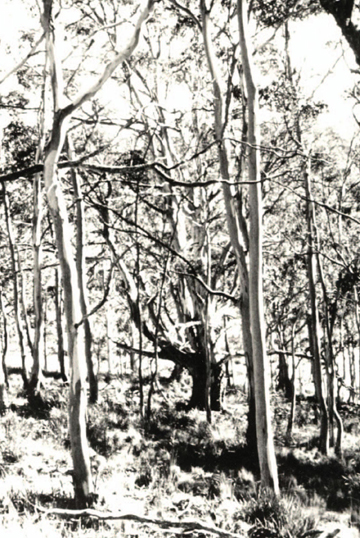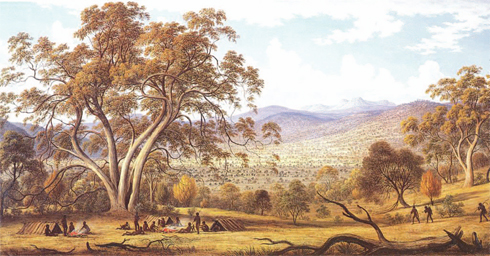Plain Facts: Tasmania under Aboriginal Management
Bill Gammage. 2008. Plain Facts: Tasmania under Aboriginal Management. Landscape Research, Vol. 33, No. 2, 241 – 254, April 2008.
Full text [here]
Selected excerpts
Abstract
Almost all researchers now accept that Australia’s Aborigines were managing their country with the broad-scale use of fire when Europeans arrived. In respect to Tasmania, this article goes further, arguing that fire was not merely broad-scale, but applied variably and precisely, to make, then connect, a complex range of useful ecosystems. The article also argues that Aboriginal land management must be seen in cultural as well as ecological terms.
*****
When Europeans arrived, the Aborigines of Tasmania were managing their land by using fire to arrange its vegetation. They did so to ensure that all species flourished as the Law required, to make resources abundant, convenient and predictable, and to make the land an integrated domain.
Although such acute early observers as Thomas Mitchell and Ludwig Leichhardt knew that Aborigines fired country to attract game,1 not until the 1960s did researchers begin to sense system and purpose in Aboriginal burning. From 1965, Bill Jackson argued that for thousands of years Tasmanians altered vegetation by deliberate and repeated firing.2 In 1968, Duncan Merrilees pointed to faunal changes in Australia which he thought could only have been caused by people.3 In 1968 and 1969, Rhys Jones showed that throughout Australia ‘fire-stick farming’ made a more complex vegetation mosaic than climate alone could dictate.4 In 1975, Sylvia Hallam provided extensive evidence of purposeful firing in southwest Western Australia.5 Debate persists on whether Aborigines intended the results of such widespread, purposeful and effective firing,6 but enough evidence exists to resolve this debate, and to take it further.
The broad impact of Aboriginal burning on Tasmania’s plants is sketched by the answers to two questions. When Europeans arrived:
1) What would the land have looked like without human intervention?
2) What did it look like?
Jackson concluded that deliberate burning best explains why there was much less rainforest in Tasmania when Europeans arrived than on New Zealand’s South Island, a comparable climate but generally without people.7 As its title hints, ‘Plain Facts’ begins by echoing Jackson, arguing that but for Tasmanian fire, plains, heath and open forest would have been much less common than they were when Europeans arrived, and rainforest more common. Tasmanians burnt rainforest to diversify and arrange their resources. …

Figure 1. Gums on Basin Hill, ‘Ellesmere’, near Jericho. Source: Gums, Fred Duncan, Forest Practices Board, Hobart, 1985–1986. A similar photo is the front cover of Tasforests, 2(2), December 1990.
The big white gum (E. viminalis) is over 200 years old, possibly over 300.8 Its branches spread, unlike the surrounding saplings which grow straight up, racing for light. Note where those fast-growing youngsters caught their parent, which first lost its lowest branches to the shade, then bent its next branches up to compete for light. This tree began in the open, then adapted to woodland.
Why was the country open when the tree was young? If trees grow there now, why not then? Soil, salt, climate or aspect cannot explain the change. Fire can explain it, but not any fire, not a bushfire. Most eucalypts survive even intense bushfires, as they prove each summer. Had bushfires cleared this land the big gum would show fire damage, there would be more big gums, and we would have to explain why bushfires stopped, to let the saplings grow. Jackson estimated that only 0.6% of Tasmanian fires are bushfires.9 At Jericho the percentage is probably higher, but the fires which made this landscape were frequent and of low intensity, protecting the big gum and suppressing generations of its seedlings.
The saplings are 20th century, so the land remained open for some time after the Tasmanians were removed. Either settlers also burned until they built fences, or initially the grass was too dense to give seedlings headway, or, probably, first one then the other. …
Figure 2. JohnGlover, ‘Mills’ Plains’, 1836. Source: John Glover, ‘Mills’Plains, BenLomond, Ben Loder and Ben Nevis in the Distance’, 1836,AG3, Tasmanian Museum and Art Gallery,Hobart. Click for larger image.
On coasts, heath and grass might alternate for miles. On hills, grass pockets lay in open forest; in high country in rainforest.17 These differences reflected the good sense of working with the land, and of providing accessible habitats for all. Tasmanians burnt to associate food and shelter. Many animals and birds prefer to feed in grassland, shelter in open forest, and stay close to an edge between both, so people made edges plentiful by alternating belts of forest and plain. …
[Forest-plain belts] sheltered edge animals and concealed hunters, and were common in Tasmania.
In the northwest, Henry Hellyer thought the Surrey Hills “resemble English enclosures in many respects, being bounded by brooks between each, with belts of beautiful shrubs in every vale… the Hampshire Hills… appear even more park like than the Surrey Hills, and are handsomely clumped with trees.”19 …
Tasmanians also made edges by leaving clumps (copses) on plains. …
Clumps were maintained, not merely left after cool burns, although they may have begun that way. …
People also wedged forest into plain so that no matter how the wind lay they could approach prey undetected. …
This landscape is shaped to make game accessible. A skillful burning regime, and not that on Mill’s Plains, has kept the forest dense and the grass open. …
It is unlikely that fires were lit just to hunt. That would tax a delicate artefact. More probably, when season and wind decreed a time to burn, people hunted as well. If they spread enough edges around their country they could usually burn and hunt somewhere, and if they planned burning cycles (as they did on the mainland) they could shepherd game from one plain to the next. …
Tasmanians (and mainlanders) used plains by patch-burning them, making mosaics of fresh grass to concentrate feed, and trees or old grass to shelter game and hunters. …
Where patches were burnt determined where feed and thus game was: patches made hunting predictable. Predictability is commonly the critical advantage farmers claim over hunters, yet Tasmanian hunters went expecting to find game—more like gathering. With patches spaced over many miles, their resources were more drought, flood and fire evading, more certain, than those of farmers. Perhaps this is why farmers trade and store food whereas except in harsh parts of Australia Aborigines did not. …
Grass and eucalypt are there because generations of fire kept rainforest back. The dark ridges are surviving rainforest which “have probably not been burnt for several hundred years or more.” Some show patches or patch regeneration. If fires like the big 1933 – 1934 fire recur, the rainforest will slow and eucalypts advance. If no fires occur rainforest will capture the eucalypts, creating a common and memorable Tasmanian landscape, dense rainforest topped by giant eucalypts, survivors of the days centuries ago when fire made the land theirs. A map today of those overtopping eucalypts would show many areas which are rainforest now and were not 400 years ago, and might reveal interesting vegetation patterns.41
The scene evokes say three- to six-year cool fires keeping plains clear, say five- to 20-year cool fires making open forest, and no fires permitting rainforest. Once established, with skilled local care the landscape would have been easy to maintain. The scene is typical of the south and southwest coasts. Even in country we call wilderness, the managing hand of the Aborigines was there. …
In sum, Tasmanians burnt country or protected it from burning, used varying fire regimes to associate different plants, and distributed associations selectively. They planned so carefully for two main reasons:
1) The Law—-a philosophy sanctioned by religion—-required them to ensure the abundance or survival of every form of life.
2) Planning made convenient and predictable the plant and animal resources of every habitat.
Universal principles obliged and local knowledge allowed people to manage their land. In this Tasmanians and mainlanders were, extraordinarily, alike. Two groups separated for 10 000 years, a “degree of isolation… thought to be unparalleled in the known history of the world,”46 kept religiously to similar universal principles and local practices.
The system also tuned people’s minds to their land. Since the whole land was managed, it follows that the whole was encompassed by the Tasmanian mind. There was no wilderness, no terra nullius, in that sense no nature, because all was as people made it or allowed it to be. There was possession in the most fundamental sense. Conversely, the land made the people truly Tasmanian, committed to all the intricate detail of their world. That was their achievement and their tragedy, for it left them unable to manage the entirely unexpected—the arrival of new people with utterly different values.

